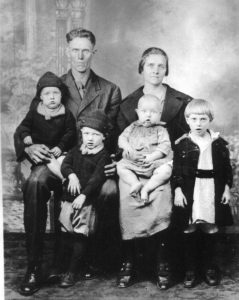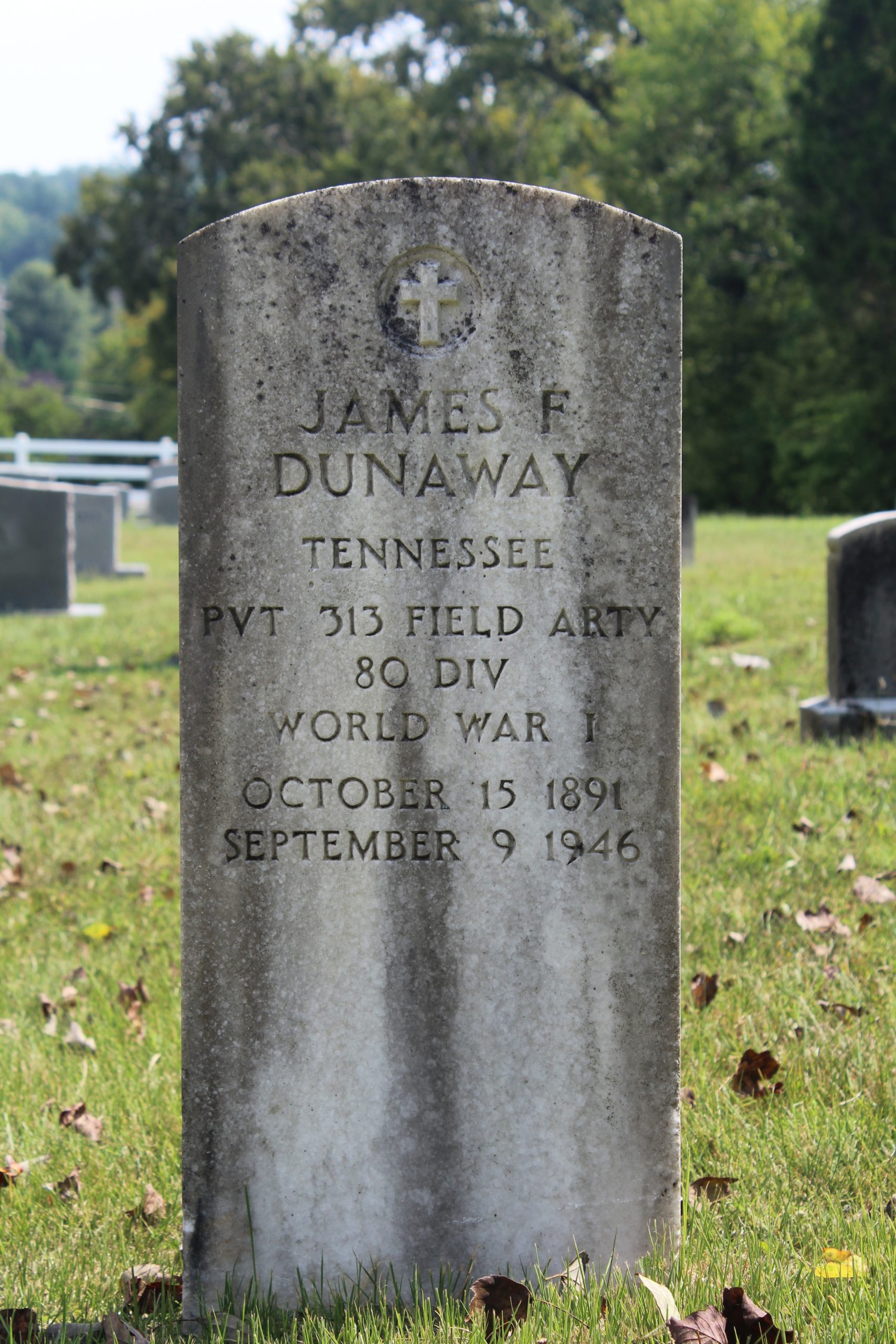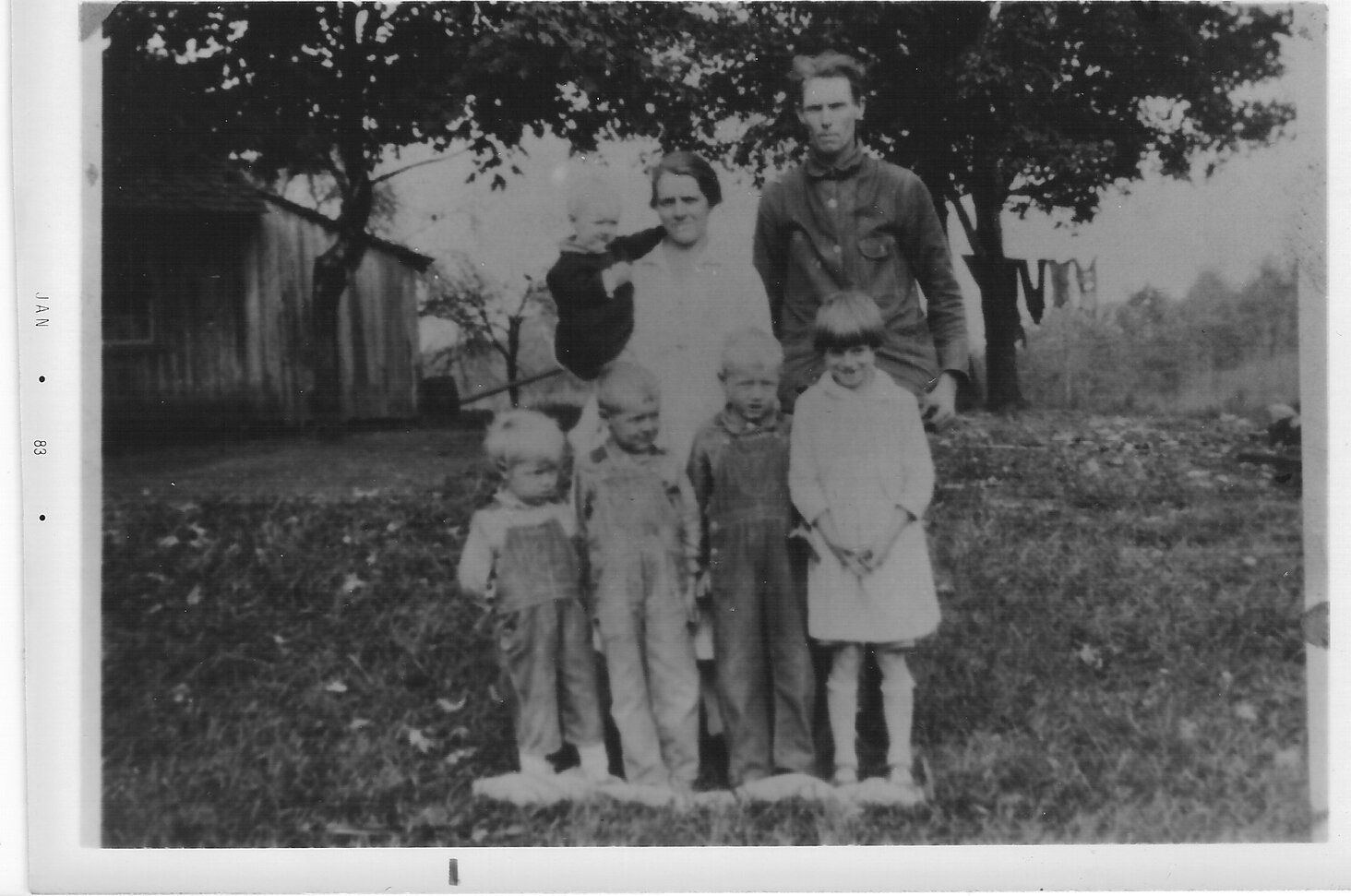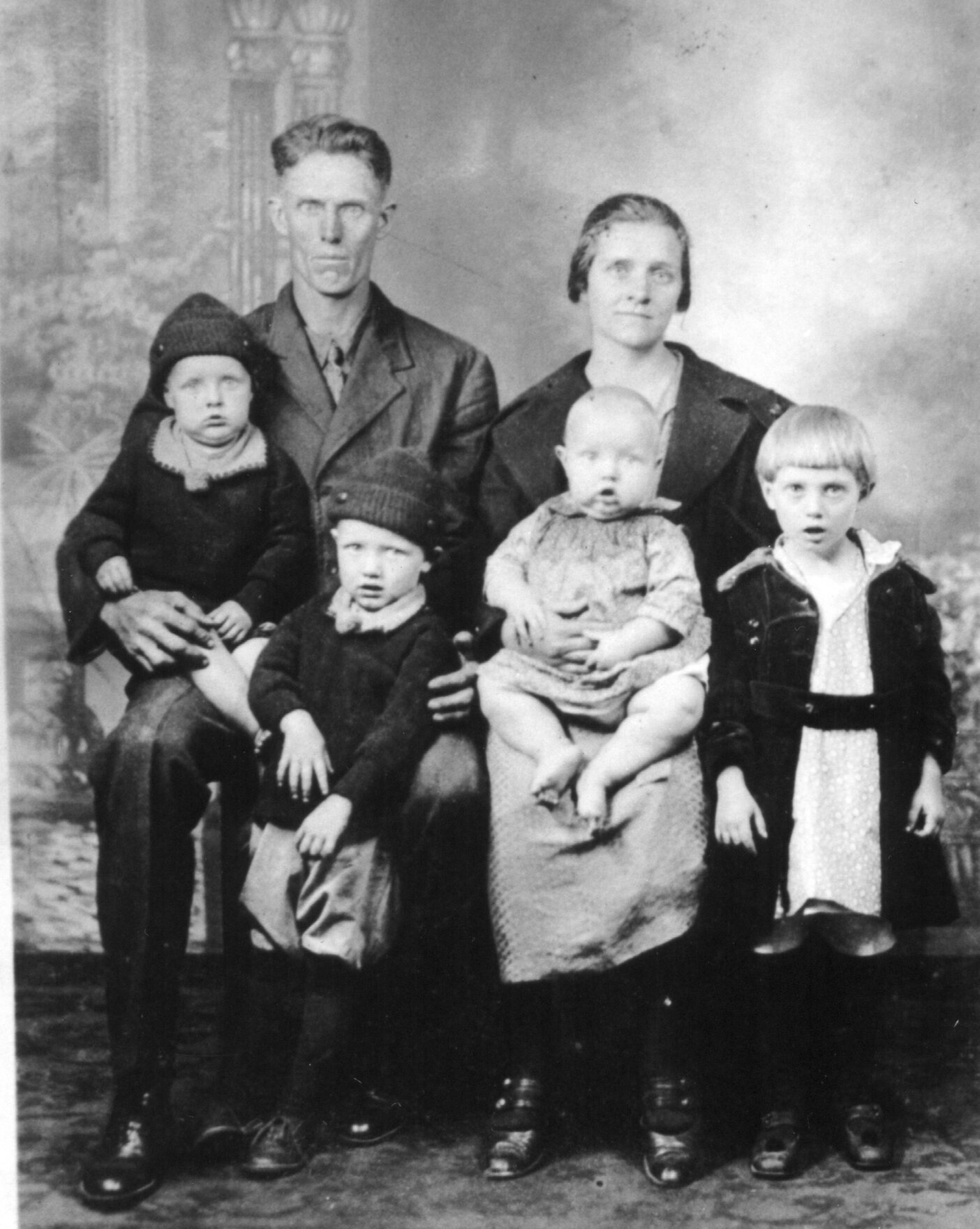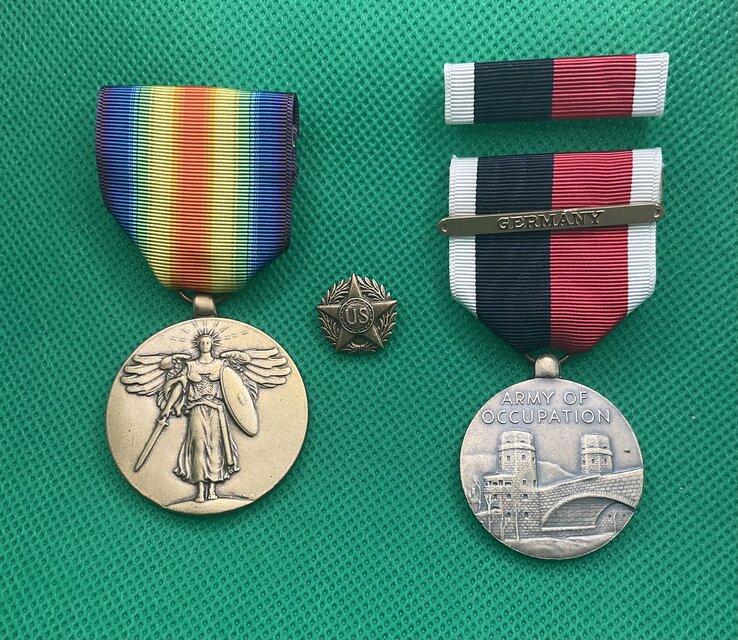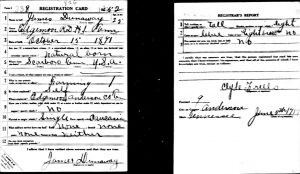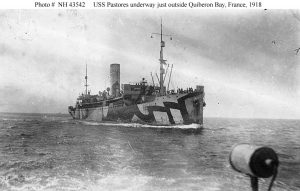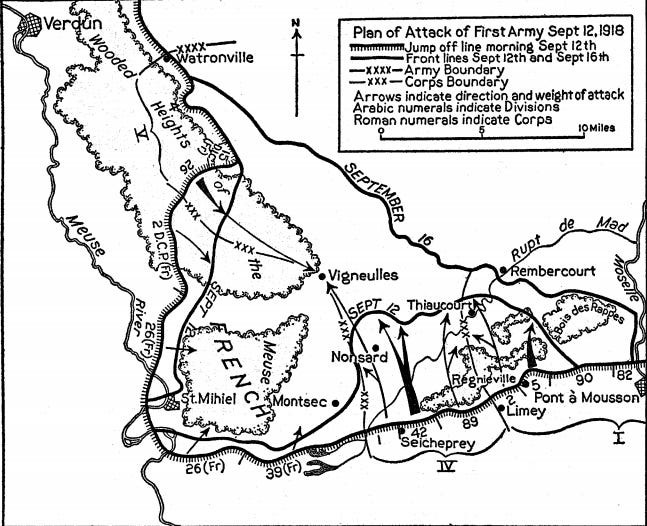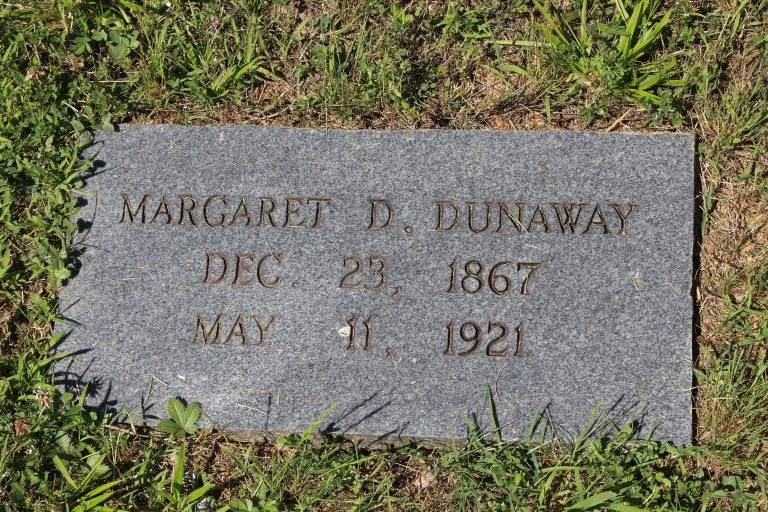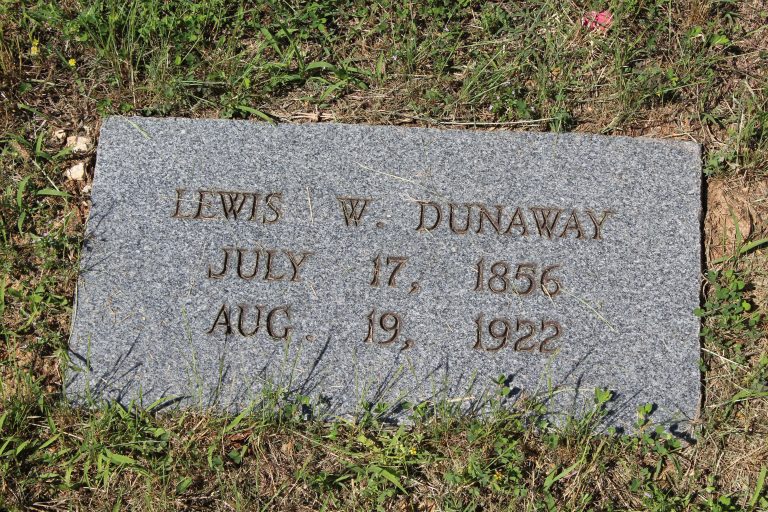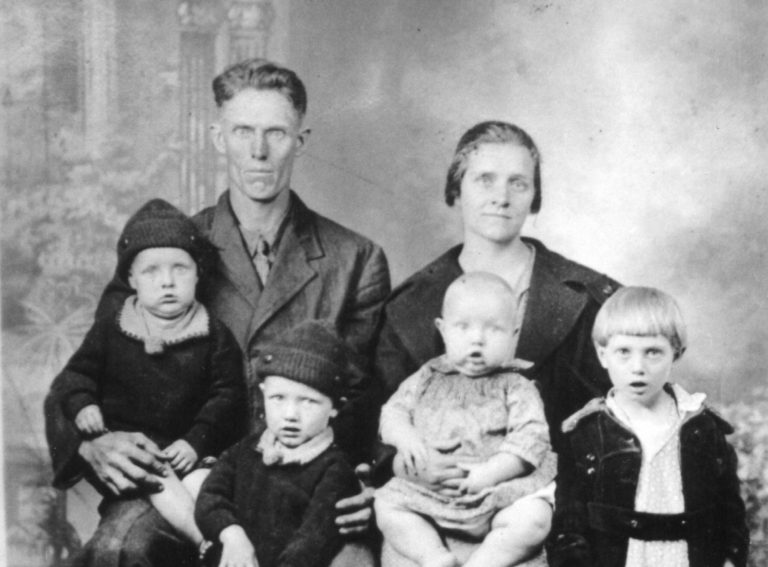James Franklin Dunaway
Born: October 15, 1891
Marriage: April 3, 1921
Death: September 9, 1946
Father: Lewis Wesley Dunaway
Mother: Maggie Dyer
Spouse: Sarah Callie Raby
Children:
Gladys Marie Dunaway Anderson (1922 – 1989)
Okey Hayes Dunaway (1923 – 2007)
Orville Arley Dunaway (1924 – 1944)
James Willard Dunaway (1925 – 1995)
Leonard Paul Dunaway (1927 – 2010)
Evelyn Mae Dunaway Emert (1929 – 2000)
Clyde Freeman Dunaway (1931 – 2012)
Franklin Columbus Dunaway (1933 – 2022)
Sarah Annette Dunaway Huckaby (1935 – )
John Lewis Dunaway (1937 – 2017)
The Life of James Franklin Dunaway
Jump to…
1. Early Life
2. Call to War
3. Off to France
4. War is Hell
5. Waiting to Go Home
6. Home at Last
Early Life
My grandfather, James Franklin Dunaway, was born on October 15, 1891, in the Scarborough community of Anderson County, Tennessee. He was the fourth of nine children (the second son) born to Lewis Wesley Dunaway and Margaret “Maggie” Dyer Dunaway.
According to the Twelfth Census of the United States in 1900, he was no longer living in Anderson County, but instead he was living in the Byington/Solway area of the 9th Civil District of Knox County, Tennessee, on a farm owned by his father when the enumeration was done on June 13th. He was eight years old at the time and had attended school for the last 7 months prior to the census being taken.
Ten years later in the 1910 Census, James was eighteen years old and still living with his parents and siblings on McClure Ferry Road in the old part of the 9th Civil District of Knox County, Tennessee. They were living in a rented house at the time and it was not part of a farm. He had attended school for some period of time since September 1, 1909, but had also listed his occupation as that of a farmer, working for himself.
Later in 1910 according to Jennie Dunaway Raby, Lewis Wesley Dunaway and his family (including James) moved back to Anderson County to the Freels Bend area on the Clinch River. They lived there for four years in the Freels House and then moved to the Schubert House when she was 20 years old (about 1914). “We moved to Schubert House when our father, a farmer, felt the new place was a ‘better deal,’ taking along our cows, horses, hogs, and chickens.”
Elsewhere in the world, things were not doing well. After the assassination of Archduke Franz Ferdinand of Austria and his wife, Sophie, by the Serbian nationalist Gavrilo Princip on June 28, 1914, Europe was a powder keg waiting to explode. On July 28, Austria-Hungary declared war on Serbia, and the tenuous peace between Europe’s great powers quickly collapsed. Within a week, Russia, Belgium, France, Great Britain and Serbia had lined up against Austria-Hungary and Germany, and World War I had begun.
A few years later on April 6, 1917, the United States officially entered the Great War (World War I). At that time, the United States only had a standing army of about 133,000 soldiers. To build an army rapidly, the Selective Service Act was passed by Congress on May 18, 1917. There were three registrations. The first, on June 5, 1917, was for all men between the ages of 21 and 30. The second, on June 5, 1918, registered those who attained age 21 after June 5, 1917. A supplemental registration, included in the second registration, was held on August 24, 1918, for those becoming 21 years old after June 5, 1918. The third and final registration occurred on September 12, 1918, and was for men age 18 through 45.
Shortly thereafter on June 5, 1917, James Dunaway registered for the draft in Anderson County, Tennessee. At the time of his registration, he was living in the Edgemoor Community of Anderson County, Tennessee, and was self-employed as a farmer. He was tall and of slender build with blue eyes and light brown hair. He was still living at home with his parents and siblings. His older brother, Robert Dunaway, also registered for the draft on the same day.
On June 10, 1917, shortly after James registered for the draft, the United States had assembled an army and sent troops to Europe. On July 4th of 1917, under the command of John J. Pershing, the United States 1st Division (the Big Red One) arrived in Paris, France.
(Return to index)
Call to War
Almost a year later, James Dunaway enlisted into the U.S. Army on Friday, June 7, 1918 in Clinton, Tennessee. Since there were three drafts and the second one took place on June 5, 1918, he may have been conscripted or just desired to serve — we may never know for sure. But at the time of his enlistment, he was 26 years & 8 months old, 5 feet, 11 ½ inches tall, and of slender build, with blue eyes, light brown hair, and a ruddy complexion. His occupation was still listed as “farmer” and the marks and defects noted were: “Front: C. S. 1/8 Left Knee. Back: Left Elbow C. S. 1/8, and a mole on his right shoulder blade.” C. S. is usually the acronym used for Company Surgeon, so this is likely his initial medical examination for admission to the army. He passed, so he was in. His uniform shoe size was listed as 9E.
On June 8, 1918, he was assigned to Camp Jackson, (near Columbia) South Carolina. I believe he would have travelled by rail to Camp Jackson as it is over 300 miles from Clinton, Tennessee. He was examined and passed the heart and arteries examination on June 11, 1918. He was also vaccinated on that date (type of vaccination was not stated), but the results were “unsuccessful” – the meaning of this is unclear. The tuberculosis test was examined and passed on June 11, 1918.
The Declaration of Soldier for James Dunaway was done on June 15, 1918, at Camp Jackson, and he was assigned serial number 2994277. His initial assignment was to 15 Company, 4th Training Battalion, 156 Depot Brigade. It is my understanding that all new recruits were assigned to this unit when they arrived at Camp Jackson until they had finished training and were ready to be transferred to an active unit.
About 8 days later on June 23, 1918, James was admitted to the Base Hospital at Camp Jackson. According to his records the cause for admission was measles and it was deemed to be in the line of duty. He spent a total of 17 days in the hospital and was released for active duty on July 10, 1918.
James was vaccinated again on July 20, 1918, and again the result was shown to be unsuccessful. (Cholera and Typhoid vaccines were developed in 1896 and the development of vaccines took off with a diphtheria antiserum in 1901 and tetanus antiserum in 1914. The pertussis vaccine was released in 1915 and it was the first vaccine to use inactivated cells. It is my belief that one of these vaccines were probably the one being given and noted as unsuccessful.)
Then on July 21, 1918, James was transferred to 1st Brigade, Field Artillery Replacement Depot (F.A.R.D.), Field Battery C, for deployment. On August 6, 1918, his typhoid immunization was complete and he was ready to be deployed. He was transferred again on August 6, 1918, to the 2nd Battery A.A.R.D. This could be either the August Automatic Replacement Depot or Army Artillery Replacement Depot.
On August 9, 1918, he was assigned to Battery D, 2nd Regiment, 1st Brigade at Camp Jackson. He was now prepared to be sent to Europe to serve his country in the Great War.
(Return to index)
Off to France
On August 22, 1918, at 11:00 am, James departed from Newport News, Virginia, aboard the troop ship AF-16 USS Pastores and began his voyage to Europe as part of the Battery D, 2nd Regiment, 1st Brigade, 80th Division. On the Passenger List of Organizations and Casuals, he was number two listed to be part of 2nd Battery August Automatic Replacement Draft Camp Jackson, S.C. (FA881R).
During this time in history, the typical convoy transit time of the Atlantic Ocean was 16 to 18 days due to the different vessel speeds in the convoy and the zig-zagging routes taken. According to an article in Wikipedia, the USS Pastores sighted a submarine during the January crossing and fired at it. This happened again during convoy crossings in August and September. At left is a photo of the USS Pastores taken in 1918 after the ship was acquired and painted by the US Navy on May 1, 1918. It is very possible that James was aboard this vessel at the time this photo was taken in 1918, just outside Quiburon Bay, France.
According to the military records of James’ Transfers & Changes, the USS Pastores arrived at a port in France on September 3, 1918. On the manifest they were listed as Camp Jackson AARD (August Automatic Replacement Depot). It appears they remained on board the USS Pastores for a couple of days until September 5,1918, when they finally disembarked. I have not been able to determine which port was used at this time, but may at a later date.
(Return to index)
War is Hell
After arriving on French soil on September 5, as part of the 80th Division, James’ unit was quickly moved to the front lines and used as replacements. It is likely that his unit was attached to the 313th Field Artillery as his records indicate that he was involved in their area of action.
The 313th Field Artillery Regiment played a critical role in the Allied victory in World War I. As part of the 80th Division, the regiment saw action in several major battles and provided critical fire support for infantry units during major offensives.
The 313th Field Artillery Regiment was organized and trained at Camp Lee, Virginia, and was deployed to France in May 1918. The regiment was equipped with 75mm French guns and served as part of the 155th Field Artillery Brigade.
One of the first major engagements for the 313th Field Artillery was the St. Mihiel Offensive, which took place September 12-16, 1918. During this offensive, the regiment provided support for the 320th Infantry Regiment and helped to capture the town of Thiaucourt. The 313th Field Artillery fired over 8,500 rounds during the St. Mihiel Offensive, helping to neutralize enemy artillery and clear the way for Allied infantry to advance.
There were a number of “firsts” in American history during this offensive:
- The first use of the term “D-DAY” when describing a pending invasion.
- The first tank attack in U.S. history was mounted here in support of the 42nd Division, led by George Patton, who boldly led his charges from the front lines and not from the rear as many other officers did during the war.
- The first US Operation and Victory by an independent American army, the American Expeditionary Forces (AEF).
- The battle was the first major use in the war of the U.S. Army Air Service (precursor to the U.S. Air Force) led by Col. William “Billy” Mitchell. Col. Mitchell directed the heterogeneous air force, composed of British, French, Italian, Portuguese, and American units, in what proved to be the largest single air operation of the war. American squadrons flew 609 of the airplanes, which were mostly of French or British manufacture.
After the St. Mihiel Offensive, the 313th Field Artillery was involved in the Meuse-Argonne Offensive, the final Allied offensive of the war. The Meuse-Argonne Offensive began on September 26, 1918, and continued until the Armistice on November 11, 1918. During this offensive, the regiment supported the 317th Infantry Regiment and provided fire support for the capture of several key positions, including Montfaucon and Romagne.
In total, the 313th Field Artillery fired over 50,000 rounds during the Meuse-Argonne Offensive, helping to break through the Hindenburg Line and push the German army back toward the border. The regiment suffered several casualties during this offensive, including 15 killed and 62 wounded.
After the end of the war, the 313th Field Artillery was involved in occupation duties in Germany before returning to the United States in April 1919. The regiment was awarded a battle streamer for its service in the Meuse-Argonne Offensive.
Overall, the 313th Field Artillery Regiment played a critical role in the Allied victory in World War I. The regiment provided critical fire support for infantry units during major offensives and helped to neutralize enemy artillery and clear the way for Allied advances. The regiment’s actions during the St. Mihiel Offensive and the Meuse-Argonne Offensive were instrumental in breaking the German army’s defenses and pushing them back toward the border. The 313th Field Artillery Regiment’s service and sacrifice helped to secure victory for the Allied powers and end the Great War.
However, it is estimated that there were approximately 1,200 to 1,500 artillery batteries serving with the American Expeditionary Forces (AEF) in Europe during the war. These batteries were equipped with a variety of artillery pieces, including field guns, howitzers, and mortars, and were used to provide support to infantry units and to engage enemy positions and fortifications.
A typical field artillery battery during World War I was comprised of approximately six to eight officers and 128 to 140 enlisted men. In addition to the personnel who operated the artillery pieces, a field artillery battery during World War I would also include medical personnel, cooks, and other support personnel. The exact number of soldiers in a battery would vary depending on the specific needs of the unit and the type of artillery it was equipped with.
There were typically four to six artillery pieces. The type of artillery pieces varied, but the most common types were howitzers and guns, such as the French 75mm gun or the British 18-pounder field gun.
In general, the artillery pieces in a field artillery battery during World War I were transported by horse-drawn wagons, and the battery was often supported by a detachment of infantry for protection.
During World War I, the total number of allied military deaths is estimated to be around five million. The exact number is difficult to determine due to incomplete records and variations in estimates among sources. Among the major allied powers, Russia suffered the most military deaths with approximately 1.8 million, followed by France with approximately 1.4 million, the United Kingdom with approximately 887,000, Italy with approximately 651,000, and the United States with approximately 116,000. Other smaller allied powers also suffered significant losses.
The opposing side to the Allied powers was the Central Powers, which consisted of Germany, Austria-Hungary, the Ottoman Empire, and Bulgaria. The total number of military deaths among the Central Powers is estimated to be around 4 million. Among the Central Powers, Germany suffered the most military deaths with nearly two million, followed by Austria-Hungary with approximately 1.2 million, the Ottoman Empire with approximately 325,000, and Bulgaria with approximately 87,000.
(Return to index)
Waiting to Go Home
The Armistice was signed on November 11, 1918, and the fighting was finally over, but it would be months before the soldiers were able to return home. There were occupation duties to be done in Germany and the logistics of getting all the troops moved to the coast for transportation home.
There was a Report of Change for James dated January 30, 1919:
Transferred to 319 F.A. Feb. 1st, pp7, SO 30, Hq 80 Div. 30 Jan. 1919. Hq. 319th Inf. Cruzy-le-Chatel, France, for the 24 hours ending midnight 5 February 1919. This was signed by Byron Van Etten, Captain, 319th Infantry. James’ army specialty was listed as Ammunition Cannoneer in the Field Artillery unit.
During battles, the ammunition cannoneer was responsible for the safe and efficient handling of ammunition for artillery pieces. This role was critical to the success of any artillery unit, as without a steady and reliable supply of ammunition, the guns would quickly become ineffective.
The ammunition cannoneer’s duties included receiving, inspecting, and storing ammunition, as well as transporting it to the guns when needed. They also had to be knowledgeable about the various types of ammunition used by the artillery unit and be able to quickly identify and retrieve the appropriate rounds.
The following information is from the Record of Events from a book titled “A History of the 313th Field Artillery U.S.A.” by Thomas Irving Crowell. This is an actual account from those who were there and provides an insight as to what James would have been doing while waiting for his orders to return to the United States of America. I believe he was attached to the 313th during the offensives, but he was officially transferred into the 313th on February 1, 1919.
January, 1919
Assigned
Attached
7 Enlisted men died of disease.
Officers
47
12
Enlisted
1144
38
Horses
578
“The regiment was engaged in training the entire month. 1st Battalion and Headquarters Company were billeted in Argenteuil; 2d Battalion in Ancy- le-Libre, and the Supply Company in Pacy, France the entire month.”
February, 1919
Assigned
Attached
Officers
43
11
Enlisted
1352
37
Horses
570
“Regiment stationed in the same places as the month before. The Regiment was engaged in training during the entire month.”
March, 1919
Assigned
Attached
1 enlisted man died of accident
Officers
46
7
Enlisted
1313
36
“The 1st Battalion Headquarters Company, Medical and Veterinary Detachments were billeted and engaged in training at Argenteuil, France, 1-30 March, 1919. Supply Company was billeted and engaged in training at Pacy, France, 1-30 March, 1919. The 2d Battalion was billeted and engaged in training at Ancy-le-Libre, France, 1-30 March, 1919.
“Regimental Headquarters, 1st Battalion Headquarters, Headquarters Company, Medical and Veterinary Detachments and Batteries A B and C left Argenteuil, France, 30 March, 1919 and arrived at Chateau-du-Loir, France, 1 April, 1919. The 2d Battalion Headquarters and Batteries D and E left Ancy- le-Libre, France, 30 March, 1919 and arrived at Chateau-du-Loir, 1 April, 1919. The Supply Company left Pacy, France, 30 March, [1919 and arrived at Chateau-du-Loir, 1 April, 1919. Battery F left Ancy-le-Libre, France, 31 March, 1919 and arrived at Chateau-du-Loir, France, 1 April, 1919.
“All the organizations of the 313th Field Artillery entrained at Pacy (Yonne), France.”
April, 1919
Assigned
Attached
1st Casual Co.
2nd Casual Co.
Officers
45
7
Enlisted
1300
36
120
122
“The Regiment was stationed at Chateau-du-Loir (Sarthe) the entire month, preparing for return to the U. S. It was inspected 21 April, 1919 by Officers from Headquarters American Embarkation Center.
“Received 242 Casuals 26 April, 1919 which were divided into two companies designated as the First and Second Casual Companies.”
May, 1919
Assigned
Attached
Officers
45
6
Enlisted
1273
36
“The Regiment left Chateau-du-Loir (Sarthe), France, May 10, 1919 and arrived at Camp Pontanezen (Brest), France, May 11, 1919. Left Brest, France, on the U. S. S. ‘Zeppelin’ for the United States, May 17, 1919 per embarkation order Number 226, Troop Movement Office, Base Section Number 5, May 16, 1919, and arrived at Newport News, Virginia, May 28, 1919. Marched about 1 1/2 miles to Camp Stuart, Virginia, where the remainder of the month was spent.
“First and Second Casual Companies consisting of 242 men were detached from regiment.”
June, 1919
“Regimental Headquarters, Field and Staff Headquarters Company, Supply Company and Battery A left Camp Stuart, Virginia, June 1, 1919 and arrived at Camp Lee, Virginia, June 2, 1919. Batteries B, C, D, E, F, Medical Detachment, Veterinary Detachment and Ordnance Detachment left Camp Stuart, Virginia, June 2, 1919, and arrived at Camp Lee, Virginia same date. The process of demobilization of the regiment began at once and was completed June 6, 1919. The final disposition of the officers and enlisted men was as follows:
26 Officers Transferred
25 Officers Discharged
206 Enlisted Men Transferred
1103 Enlisted Men Discharged
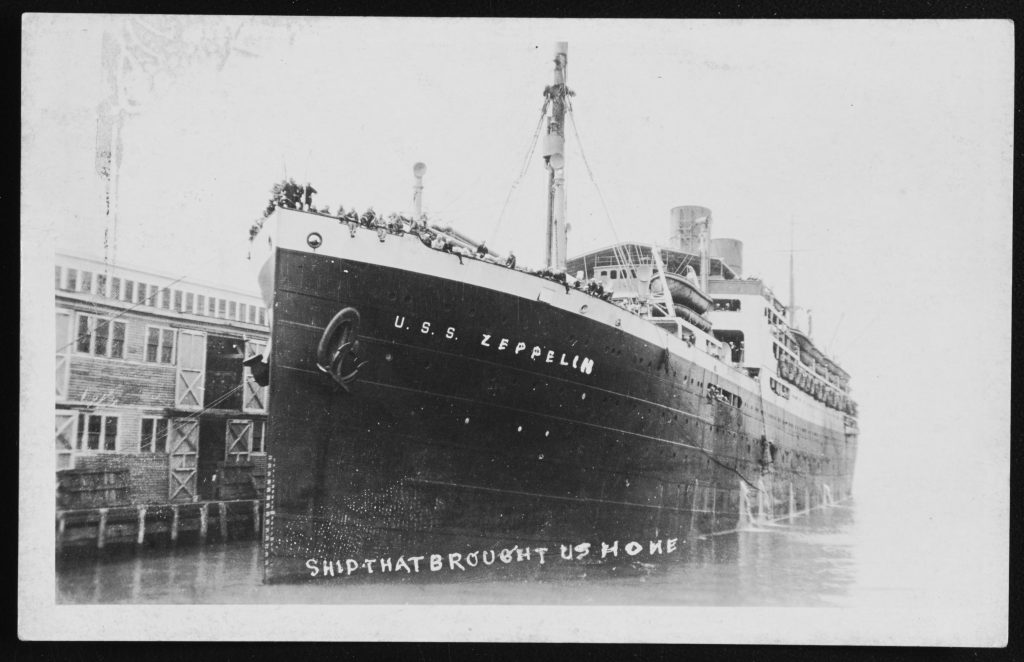
On June 10, 1919, James was transferred to Camp Zachary Taylor near Louisville, Kentucky. Then on June 20, 1919, he was Honorably Discharged and his character was rated Excellent. At the time of his discharge from the army he was a private serving in Battery “C” of the 313th Field Artillery.
(Return to index)
Home at Last
Like other soldiers who survived this bloody conflict, James returned home and tried to resume a normal life. By the end of World War I, there were approximately 116,516 American soldiers who had been killed or who had died from disease in addition to the tens of thousands who came home with wounds, visible and invisible.
According to what I was told by his younger sister, Jennie June Dunaway Raby, James was never the same after he returned from the war. Considering he had been buried alive from an artillery barrage; exposed to any one of the various gases, including mustard, chlorine, phosgene, or tear gas; was often poorly clothed, perpetually wet, and exposed to the elements for weeks at a time; and he saw thousands of fellow soldiers maimed, crippled, or killed, it’s no wonder — events such as these had to leave lasting effects on one’s life.
After being discharged from the army, he returned to Tennessee. The 1920 United States census shows him living with his older brother, Robert Houston Dunaway, on Solway Road in the 9th Civil District in Knox County. His occupation was shown as “labor on a home farm” and his father and mother were also shown to be living with Robert, who was listed as Head of Household.
Living next door to Robert H. Dunaway was John Columbus Raby, his wife Lucinda Cooley Raby, his son Will and his daughter Sarah Callie Raby, whom James married on April 3, 1921, in Knox County, Tennessee. To this union, 10 children were born: Gladys Marie, Okey Hayse, Orville Arley, James Willard, Leonard Paul, Evelyn Mae, Clyde Freeman, Franklin Columbus, Sarah Annette, and John Lewis.
On February 3, 1925, James applied for the World War Adjusted Compensation Act of 1924 for services rendered during the Great War. This bill was passed to compensate the veterans who had served from April 17, 1917 to November 12, 1918 in the Armed Forces. Those who served the entire time in the United States were to receive up to $500.00 and those that served overseas were to receive up to $650.00. The form was witnessed by Will Raby who had known him for 10 years and J. L. Guinn who had known him for 20 years. James was paid $389.00 on February 25, 1925, for his service in the war.
The initial homeplace of James and Callie Dunaway was near the Clinch River in Knox County, Tennessee, where the first five children were born. Later they were forced to relocate their household to a location near the corner of Guinn Road and Lee Ford, both dirt roads (later, Lee Ford was changed to Swafford Road). The five younger children were born at this location.
According to his sister, Jennie, James had the “sickness” (Hereditary Angio Edema) that afflicted his sister Elizabeth Volina Dunaway Nauman and numerous other descendants.
James died at 5:50 pm on September 9, 1946, at his home in Byington/Solway, Tennessee, of pneumonia with contributing factors listed as Paralysis Agitans (Parkinson’s Disease). He was buried on September 12, 1946, in the Solway Methodist Cemetery (Lower Church). His final resting place is adjacent to his wife Sarah Callie (Raby) Dunaway, with his son Orville Dunaway nearby. The Coordinates for his grave are: N35 57.973′ and W084 11.120′ at +/- 17 ft.
